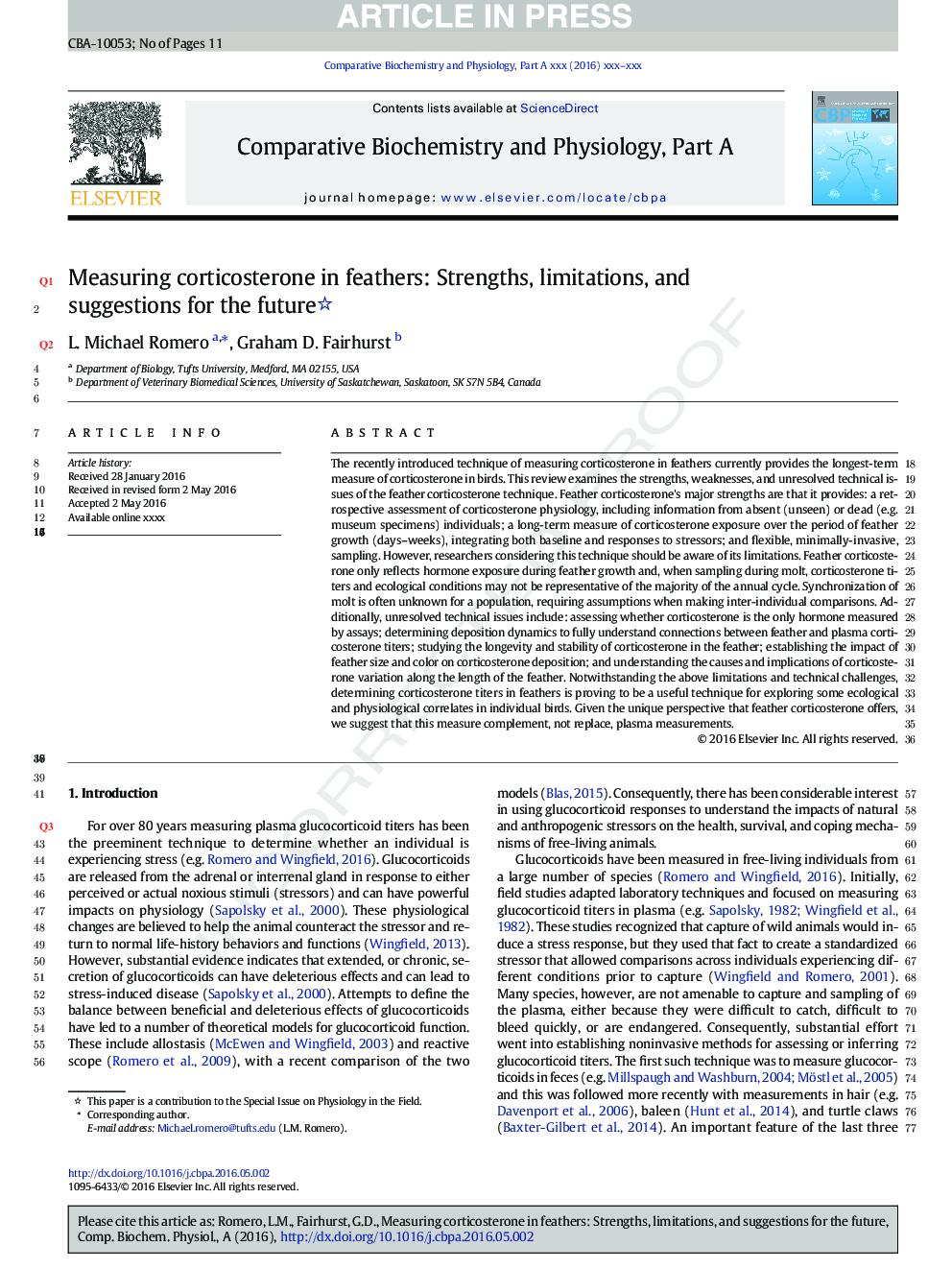| کد مقاله | کد نشریه | سال انتشار | مقاله انگلیسی | نسخه تمام متن |
|---|---|---|---|---|
| 5510355 | 1538985 | 2016 | 11 صفحه PDF | دانلود رایگان |
عنوان انگلیسی مقاله ISI
Measuring corticosterone in feathers: Strengths, limitations, and suggestions for the future
ترجمه فارسی عنوان
اندازه گیری کورتیکواسترون در پرها: شدت ها، محدودیت ها و پیشنهادات برای آینده
دانلود مقاله + سفارش ترجمه
دانلود مقاله ISI انگلیسی
رایگان برای ایرانیان
ترجمه چکیده
اخیرا تکنیک اندازه گیری کورتیکواسترون در پرها، اندازه گیری طولانی مدت کورتیکواسترون در پرندگان را فراهم می کند. این بررسی نقاط قوت، نقاط ضعف و مسائل فنی حل نشده کورتیکوسترول پر را بررسی می کند. نقاط قوت کورتیکواسترویان پر بودن آن عبارتند از: ارزیابی گذشته نگر از فیزیولوژی کورتیکواسترونی، از جمله اطلاعاتی که از وجود (غیر قابل مشاهده) یا مرده (مانند نمونه های موزه) یک اندازه گیری طولانی مدت کورتیکوسترون در طی دوره رشد پرها (روزها و هفته ها)، همگن سازی هر دو خط مقدم و پاسخ به عوامل استرس زا؛ و انعطاف پذیر، حداقل تهاجمی، نمونه برداری. با این حال، محققان با توجه به این تکنیک باید از محدودیت ها آگاه باشند. کورتیکوسترول پر تنها نشان دهنده قرار گرفتن در معرض هورمون در طی رشد پرها است و در هنگام نمونه برداری در طول گلدان، شاخص های کورتیکواسترون و شرایط اکولوژیکی ممکن است نماینده اکثریت چرخه سالانه نباشد. همگام سازی رس در اغلب موارد برای یک جمعیت ناشناخته است، و در هنگام مقایسه بین فردی نیاز به فرضیه دارد. علاوه بر این، مسائل فنی حل نشده عبارتند از: ارزیابی اینکه آیا کورتیکواسترون تنها هورمون اندازه گیری شده توسط آزمایشات است؛ تعیین دینامیک رسوب برای شناخت کامل اتصالات بین پره و کراتوکتاسترون پلاسما؛ مطالعه طول عمر و پایداری کورتیکوسترون در پر؛ تأثیر اندازه پرها و رنگ روی رسوب کورتیکوسترون؛ و درک علل و پیامدهای تغییرات کورتیکواسترونی در طول طول پر. با وجود محدودیت های بالا و چالش های فنی، تعیین شاخص های کورتیکوسترون در پرها، اثبات شده است که یک روش مفید برای کاوش برخی از همبستگی های زیستشناختی و فیزیولوژیک در پرندگان اختصاصی است. با توجه به چشم انداز منحصر به فرد که کورتیکوسترون پر می دهد، ما پیشنهاد می کنیم که این اندازه گیری مکمل، نه جایگزین اندازه گیری های پلاسما.
موضوعات مرتبط
علوم زیستی و بیوفناوری
بیوشیمی، ژنتیک و زیست شناسی مولکولی
زیست شیمی
چکیده انگلیسی
The recently introduced technique of measuring corticosterone in feathers currently provides the longest-term measure of corticosterone in birds. This review examines the strengths, weaknesses, and unresolved technical issues of the feather corticosterone technique. Feather corticosterone's major strengths are that it provides: a retrospective assessment of corticosterone physiology, including information from absent (unseen) or dead (e.g. museum specimens) individuals; a long-term measure of corticosterone exposure over the period of feather growth (days-weeks), integrating both baseline and responses to stressors; and flexible, minimally-invasive, sampling. However, researchers considering this technique should be aware of its limitations. Feather corticosterone only reflects hormone exposure during feather growth and, when sampling during molt, corticosterone titers and ecological conditions may not be representative of the majority of the annual cycle. Synchronization of molt is often unknown for a population, requiring assumptions when making inter-individual comparisons. Additionally, unresolved technical issues include: assessing whether corticosterone is the only hormone measured by assays; determining deposition dynamics to fully understand connections between feather and plasma corticosterone titers; studying the longevity and stability of corticosterone in the feather; establishing the impact of feather size and color on corticosterone deposition; and understanding the causes and implications of corticosterone variation along the length of the feather. Notwithstanding the above limitations and technical challenges, determining corticosterone titers in feathers is proving to be a useful technique for exploring some ecological and physiological correlates in individual birds. Given the unique perspective that feather corticosterone offers, we suggest that this measure complement, not replace, plasma measurements.
ناشر
Database: Elsevier - ScienceDirect (ساینس دایرکت)
Journal: Comparative Biochemistry and Physiology Part A: Molecular & Integrative Physiology - Volume 202, December 2016, Pages 112-122
Journal: Comparative Biochemistry and Physiology Part A: Molecular & Integrative Physiology - Volume 202, December 2016, Pages 112-122
نویسندگان
L. Michael Romero, Graham D. Fairhurst,
